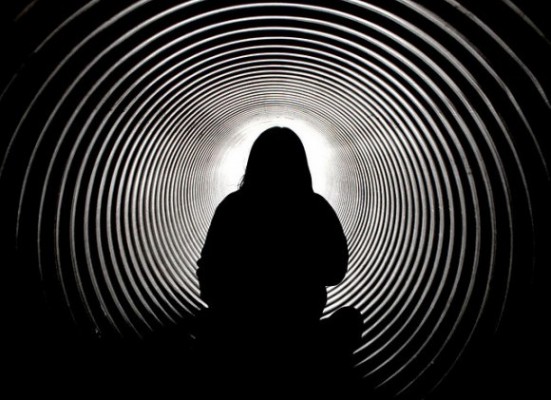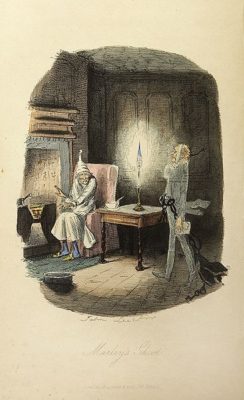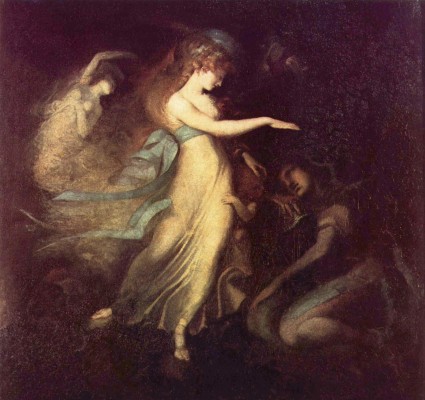The creatures of sleep paralysis: creepy, sometimes horrifying, and yet, predictable. Even given the horrific variety of shapes that the entities take, they do behave in some reliable ways. Mapping their characteristics is an important step for gaining mastery over sleep paralysis, because each presents unique opportunities to seize back control of the situation.What’s more, knowing how these visions shift and move can allow us to remove the cloak of fear and see these creatures for who they truly are.
Varieties of the Stranger
Following the clinical work of JA Cheyne, sleep paralysis symptoms can be divided into three main groups: the Intruder, the Incubus, and Vestibular-Motor hallucinations [1]. Today we are exploring the first two of these symptoms which often come together. V-M hallucinations, which include out-of-body experiences, are something I explore at length here.
The Intruder
At first, you only feel the “presence” of someone else in the room or perhaps at the doorway. The sense of presence is not based on any visual imagery but is rather a “gut feeling” that you are no longer alone. You may feel as if someone cruel is standing right behind your head or just out-of-view. This is usually an uncomfortable feeling because, of course, you cannot move or talk. Because of fear, it’s common to think that this “other person” is evil. Some people also feel that the presence is watching them.

Next, the Intruder will make itself known, but it is hard to see or ambiguous in nature. I call this in-between stage “the shadows.”
Here you may actually see a darkened figure in the doorway or a silhouette by the window. But you cannot see the figure’s face. Sometimes, like in the novel Dracula story, there may be mists or fog that coalesce into a dark figure. Sometimes you may then sense that it is getting closer to you. You may feel the mattress sink as it sits next to you on the bed, or you may just sense that the Stranger is standing right next to you.
Bad odors are frequently reported, and the air can change temperature, becoming either quite chilly, or sodden and fetid. This is striking as most sleeping nightmares do not include this sense impression. What makes this stage of the Stranger so terrifying is precisely its unknown identity. This is also the stage when you can most easily break out of the Stranger’s grasp.
Also, some people report hearing the Stranger’s footsteps approaching. Often, the sound is like someone shuffling his feet. Others hear the sound of something being dragged across the floor, like a heavy clothes bag or even chains (such as the Ghost of Marley in Dickens’ A Christmas Carol).

A theory that helps explain this phenomenon is co-creative dream theory, which suggests that our conscious intentions and attitude can alter a dream or hallucination at specific junctions called choice points [2].
Finally, you may get a glimpse of what the figure looks like from a distance. At this stage, fear can be so intense that the sound of your throbbing heartbeat may be louder than anything else. Many people who have remained quiet, hoping the Stranger would go away, start to scream––only to find out that they can’t.
What does the apparition look like? The visage is different for everyone, but suffice to say that it parallels your worst fears. And there may be more than one entity. Indeed, some people seem predisposed to be visited by groups of apparitions rather than a single figure.
[Trigger warning] Accounts from past sufferers include descriptions of demons, hairy monsters, disfigured people, hooded figures with gleaming red or yellow eyes, the Devil, witches, hags, vampires or werewolves, giants, undead zombies, aliens with big grey eyes, and, for some, people who once tortured or sexually abused them.
These figures also seem intelligent; there is a quality in their eyes that they know exactly what they are doing. And they laugh if you tell them they are “just a dream.” For more details, I explore some cross-cultural varieties of sleep paralysis figures here, and some historic interpretations here.
The Incubus
The incubus is the classic “nightmare” in which the Stranger can make physical contact. Generally these are assault experiences that are enacted by an invisible presence. It may put its hands on your throat and choke you, sit on your chest, and invoke real pain.
Be warned, accounts can be quite graphic and disturbing. Although the threat of assault is more common, some report strong sensations of sexual assault, including realistic penetrative intercourse that can painful, pleasurable, or both. The victim may feel scared, but also highly alert and awake with all thinking faculties intact.

People report, “I was awake!” It does not feel like “just a dream.” Keep in mind, an Incubus attack is psychologically real, and the terror it causes can actually retrigger old traumatic memories. This is why sleep paralysis is taken seriously by psychologists, especially if when combined with other conditions, such as panic disorder and Post Traumatic Stress Disorder.
Facing the Unknown
Knowing the major manifestations of the Stranger (The sensed presence, the shadows, the seen Intruder, and the Incubus) is the key to preventing a full-blown panic attack. When the Stranger is transitioning into another form, we have a special opportunity to co-create the experience using the power of will and the grace of acceptance.
Let me review. The Stranger manifests during hiccup of our mind’s shifting between states of consciousness, specifically when REM sleep intrudes into waking life. The ambiguity of the presence (which is a dream projecting into the waking world) triggers our fight-or-flight responses.
This fear then colors the dream-like imagery that we are generating in this waking vision and solidifies the autonomous presence into a nightmare tailor-made from pan-human archetypal imagery as well as our personal fears and cultural background.
But here is where it gets interesting…. if you can control your fear, you can shift this encounter away from the default nightmarish progression of the Stranger, so that the fuller range of possibilities emerges.
Turning the Mirror
Once we realize the terrorizing Stranger is a visionary figure twisted and amplified by fear and distrust, something big shifts. When positive feelings of curiosity, love, acceptance and trust are focused upon these apparitions, they can transform into comforting presences that are literally the stuff of legend.

At other times, the apparition may keep its original form, but become more communicative and less threatening when we become more accessible.
Rather than menacing black dogs, you may find your loved childhood pet. Instead of a creepy old hag, you may receive advice from a venerable wise woman. Creepy succubi give way to playful and tantalizing spirits, and aliens reveal themselves to be angels. It all begins when we start to swallow our fears.
To be clear, as I’m often misunderstood on this point: I’m not saying that “positive thinking” washes away the identity of a sleep paralysis entity like some kind of new-age laundry mat. Rather, the range shifts for that particular encounter with an autonomous construct. The process is different for everyone, and may take more support for those suffering from trauma or PTSD.

Are these strangers really aliens, or angels or ancestors then? Or just reflections of the unconscious mind, which excels at projecting selfhood onto other creatures and even inanimate forces (which itself is the cognitive basis for social cooperation amongst upper primates and our hominid ancestors) ?
Is it just a mirror or a celestial telephone connecting us to other intelligences?
Honestly, I don’t know. I don’t have all the answers. Maybe both, maybe neither. As a researcher, I try to stay open to all possibilities. But I do know as a practitioner that once our own projected fears stop clouding the sleep paralysis vision, a more authentic encounter is possible.
This is next level dreaming. This is the hidden pool that mystics swim in.
I invite you to share your own experiences below.
This essay is drawn from my book Sleep paralysis: A guide to hypnagogic visions and visitors of the night, which is now offered in 2nd edition, expanded and updated.
Additional sources:
[1] Cheyne, J.A. (2003). Sleep paralysis and the structure of wak- ing-nightmare hallucinations. Dreaming, 13(3), pp. 163-179.
[2] Sparrow, G.S. (2013). Imagery change analysis: Working with imagery from the standpoint of Co-creative Dream Theory. A presentation given at the annual PsiberDreaming Conference of the International Association for the Study of Dreams.
I have experienced sleep paralysis as described above, with terrifying shadowy figures circling above me or a face hovering just above mine. First time it happened I was convinced that the room I was sleeping in was haunted (my parents’ attic), so it was actually a relief to learn about this condition haha. However, more often I get what i call auditory hallucinations when I am on the edge of sleep and wake – I hear people inside my home or just outside my bedroom window (I live alone) and this morning there was clearly someone brushing their teeth in my bathroom. It’s not always frightening or threatening, sometimes I hear a cricket match commentary like someone left a radio or TV on, but when it sounds like someone is in the house, I do fight to try and get up to go check I’m not actually suffering a home invasion (by someone with obsessive dental hygiene, obviously) or something, and must be in the state of sleep paralysis because I just cannot move. More recently, when I find this happens I can generally recognise that it almost certainly isn’t real, but it is still disconcerting. Does this count?
Hi Adrienne, sounds like you have a rich hypnagogic dream life! Yes, this counts, absolutely. Recognizing “I am in sleep paralysis” can in itself be a relief and shift the mood, because with that realization comes the power of choice. To wake up, to listen and be curious, or to even try doing something like going out-of-body. So many possibilities open up with that awareness!
One of the strangest things about ‘reality testing’ such experiences is that one can conclude the experience is totally real, at the time. Even on becoming fully awake and aware afterwards, one can still be totally convinced that the experience one just had really happened, no matter how bizarre and no matter how much one later grasps it was ‘just a dream’. It feels no different to reality testing one’s waking state, in which it is obvious one is awake…and in this altered state one reaches the same conclusion ! This is very odd, as I also use reality testing ( asking myself am I dreaming ) to achieve lucid dreaming and in ‘normal’ dream states it works every time and I know I am dreaming. I’ve recorded this often in my dream diary.
Another bizarre phenomenon, which many would not notice without a dream diary, is repetition of the exact same dream….often quite complex themes…sometimes with years in between. This defies the standard explanation that dreams are just sorting out the day’s memories.
And I’d love any psychologist to explain why ‘home’ in my frequent dreams of being ‘lost in some strange town and can’t get home’ ( a common theme I have ) is still a town I have not lived in for 26 years. That is a real mystery.
yes! as a hybrid space, traditional reality tests don’t work. Instead I encourage the development of a mantra, something easily memorized, for calming down and staying with the experience (or waking up and getting the h*ll out)